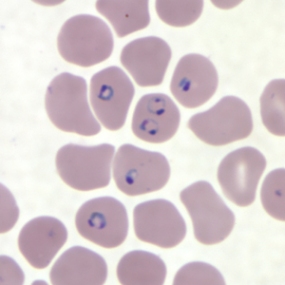Wanted: Antibodies that render malaria pathogens harmless
A protective vaccination against the parasite Plasmodium falciparum and thus against the dreaded malaria tropica should ideally take effect immediately after transmission of the pathogen. However, it is precisely at this stage of the parasite infection that the body's own defence system shows clear weaknesses. Scientists at the German Cancer Research Center (DKFZ) in Heidelberg have investigated what kind of antibodies are particularly effective here. The goal is to design future vaccines in such a way that the immune system mainly produces these highly effective antibodies. This could considerably improve the protective effect.

In red blood cells, the malaria pathogen Plasmodium falciparum forms characteristic ring-shaped structures.
© CDC/Wikipedia
Plasmodium falciparum is a unicellular parasite and the causative agent of the dreaded malaria tropica - the most common and at the same time most dangerous form of malaria. A vaccine against the tropical disease is not yet available. And even the most promising vaccine candidate to date, Mosquirix® (RTS,S AS01), was only able to protect less than 50 percent of the vaccinated children in a Phase III clinical study.
Plasmodium falciparum has a complicated life cycle. Transmitted by the bite of female mosquitoes of the genus Anopheles, few parasites from the salivary glands of the mosquito enter the skin as sporozoites. From there they migrate rapidly into the liver, where they develop rapidly in the liver cells*.
"In principle, the stage of sporozoites, i.e. directly after transmission to the human host, is the most sensible point of attack for a vaccination," explains Hedda Wardemann of the German Cancer Research Center. " At this stage, antibodies could stop the pathogen before it disappears in the liver cells." The vaccine candidate RTS,S AS01 is also directed against this stage - unfortunately only with limited and short-term effect. Despite the low number of parasites, it is particularly difficult for the immune system to react effectively to the pathogen at this stage, as Wardemann explains: "The sporozoites migrate into the liver cells within a few hours". An effective vaccination would therefore have to induce the production of particularly effective antibodies.
In order to find out what properties such particularly effective antibodies must have, Wardemann and an international team of scientists examined a total of 200 human antibodies directed against the central domain of a protein molecule with the abbreviation CSP (Circumsporozoite Protein) on the surface of sporozoites. "We wanted to know which area of the protein molecule the particularly effective antibodies recognise and how they are produced," said Wardemann. The central domain of CSP consists of only five different amino acid building blocks that are repeated many times in similar but not identical order in so-called motifs - like beads on a chain that are strung in different order.
The result: Antibodies that attach themselves with a high degree of binding power (affinity) to one or even several of these motifs in the central domain of the protein molecule - regardless of which motif the antibodies prefer here - proved to be particularly effective. In experiments with mice, it was possible to suppress the development of blood parasites particularly well with the aid of these highly affine antibodies.
It is still to be clarified whether the antibodies can also protect humans against malaria. "We are also currently investigating how we can get the immune system to produce such high affinity antibodies in greater numbers," said Wardemann. This knowledge must be taken into account in the development of future vaccine candidates in order to develop more effective protection.
*Plasmodia have a complicated life cycle: the sporozoites, which are transmitted during mosquito bites, attack liver cells. There they multiply asexually very quickly and mature into so-called merozoites, which then return to the bloodstream. At this stage of development, Plasmodium falciparum then multiplies rapidly in red blood cells (erythrocytes), thus triggering the actual disease. In this phase, sexual forms of the parasite also develop, the so-called gametocytes, which can now be taken up again by blood-sucking Anopheles mosquitoes and complete their life cycle in the mosquito.
Murugan R, Scally SW, Costa G, et al. Evolution of protective human antibodies against Plasmodium falciparum circumsporozoite protein repeat. Nature Medicine 2020; DOI: 10.1038/s41591-020-0881-9
With more than 3,000 employees, the German Cancer Research Center (Deutsches Krebsforschungszentrum, DKFZ) is Germany’s largest biomedical research institute. DKFZ scientists identify cancer risk factors, investigate how cancer progresses and develop new cancer prevention strategies. They are also developing new methods to diagnose tumors more precisely and treat cancer patients more successfully. The DKFZ's Cancer Information Service (KID) provides patients, interested citizens and experts with individual answers to questions relating to cancer.
To transfer promising approaches from cancer research to the clinic and thus improve the prognosis of cancer patients, the DKFZ cooperates with excellent research institutions and university hospitals throughout Germany:
The DKFZ is 90 percent financed by the Federal Ministry of Education and Research and 10 percent by the state of Baden-Württemberg. The DKFZ is a member of the Helmholtz Association of German Research Centers.

